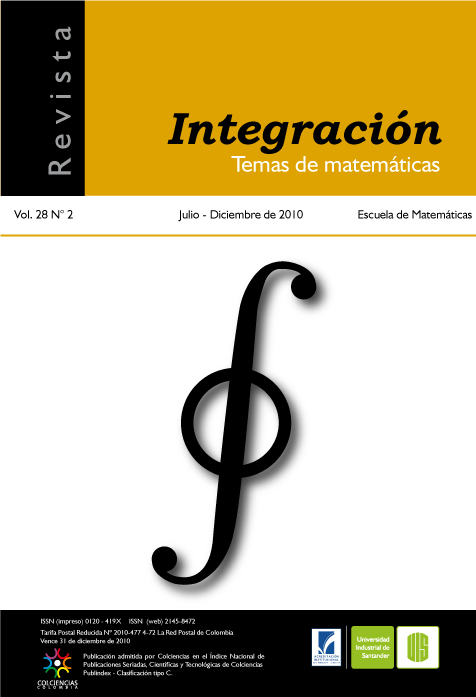Published 2010-09-21
Keywords
- Discontinuities,
- Riemann problem,
- level sets
How to Cite
Abstract
In this paper we study numerically the approximation of the Cauchy problem for a scalar conservation law by using a mixed technique which combines the principles of finite volume and level sets methods to capture with high-order the entropy solution along discontinuities. The conservation law is approximated by a finite volume scheme of second order that prevents the increase of numerical diffusion on discontinuities by incorporating ghosts states on both sides of the shock curves, which are considered as a implicit curve that is computed via the method of level sets. We present some numerical examples with application of the hybrid method and illustrate the high order accuracy belong to shock curves.
Downloads
References
[2] Aslam T., “A Level Set Algorithm for Tracking Discontinuities in Hyperbolic Conservation Laws II: Systems of Equations”, J. Sci. Comput., 19 (2003), 37–62.
[3] Dafermos C.M. “Characteristics in hyperbolic conservation laws, a study of the structure and asymptotic behaviour of solutions”, Nonlinear analysis and mechanics, Research Notes in Math. 17, Pitman, London (1977), 1–58.
[4] Dafermos C. M., Hyperbolic Conservation Laws in Continum Physics, Springer-Verlag, Berlin, 2005.
[5] Eymard R., Gallouët T. R. and Herbin R., “Finite volume method. Handbook of numerical analysis”, Vol. VII, 713-1020, Handb. Numer. Anal., VII, Nort-Holland, Amsterdam (2000).
[6] Godlewski E., Raviart P., “Numerical approximation of hyperbolic systems of conservation laws”, Appl. Math. Science, 118, Springer, New York (1996).
[7] Harten A., Engquist B., Osher S. and Chakravarthy S., “Uniformly high order essentially non-oscillatory schemes, III”, J. Comput. Phys., 71 (1987), 231–303.
[8] Jiang G.-S. and Shu C.-W., “Efficient Implementation of Weighted ENO Schemes”, Journal of Computational Physics, 126 (1996), 202–228.
[9] Kruˆzkov S. N., “First-Order Quasilinear Equations in Several Independent Variables”, Math. Sb. (N.S.), 81 (1970), 228–255.
[10] Lax P.D., “Hyperbolic systems of conservation laws, II”, Comm. Pure Appl. Math., 10 (1957), 537–566.
[11] LeVeque R., Numerical Methods for Conservation Laws, Lectures in Mathematics ETH Zürich, Birkhäuser Verlag, Basel, 1990.
[12] LeVeque R., Finite Volume Methods for Hyperbolic Problems. Cambridge University Press, United Kingdom, 2002.
[13] LeVeque R., Finite Difference Methods for Ordinary and Partial Differential Equations. Society for Industrial and Applied Mathematics, Philadelphia, United States, 2007.
[14] Oleinik O., “Discontinuous solutions of nonlinear differential gathers”, Amer. Math. Soc. Transl. Ser. 2, 26 (1963), 95–172.
[15] Osher S., and Sethian J. A., “Fronts Propagating with Curvature Dependent Speed: Algorithms Based on Hamilton-Jacobi Formulations”, J. Comput. Phys., 79 (1988), 12–49.
[16] Osher S. and Fedkiw R., “Level Set Methods: an overview and some recent results”, J. Comput. Phys., 169 (2001), 463–502.
[17] Osher S. and Fedkiw R., Level Set Methods and Dynamic Implicit Surfaces. Springer Verlag, New York, 2003.
[18] Thomas J., Numerical partial differential equations. Conservation laws and elliptic equations, Texts in Applied Mathematics, 33, Springer-Verlag, New York, 1999.
